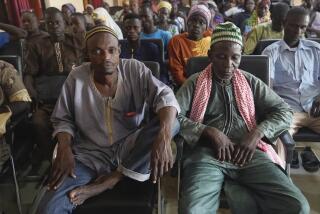Growers Earn a Living Again With Americans’ Help : Tall Corn Brings Zaire Farm Area Back to Life
- Share via
KONGOLO, Zaire — The corn is as high as an elephant’s eye, and farmers in this town that had virtually ceased to exist now are earning a living from it, with help that came chiefly from Americans.
Some area farmers have been able to buy their first radios, sewing machines and bicycles, a practical form of transportation here in Shaba, a southern district of Zaire, the country formed from the old Belgian Congo.
Corn has become the chief cash crop of northern Shaba, which became a backwater after the Simba tribal rebellions in the early 1960s. Production has tripled in 10 years, while individual farmers increased their cash crop from 300% to 1,400%.
After the bloody first years of independence from Belgium, and following two unsuccessful secessionist revolts in the 1970s, Shaba plunged into decline.
Foreigners Fled
Businessmen and other foreigners fled. An excellent road network, maintained with forced labor in the Belgian Congo, deteriorated in newly independent Zaire. Subsistance farming replaced cash crops.
Bringing it back to life was a 10-year, $30-million project--financed mostly by the United States--to open farm roads, improve seeds and teach better planting methods.
The U.S. Agency for International Development (USAID) was ordered to begin a project in the region, whose copper and other mineral exports provide two-thirds of the foreign exchange earnings of the pro-Western government of President Mobutu Sese Seko.
Corn marketed from Kongolo-area farms increased from 220 pounds per household in 1977-78 to 3,080 pounds last year. The resulting increase in income still seems low--$75 per household, according to a USAID report--but many people had cash for the first time. The annual per-capita income in all of Zaire is $170, according to the latest World Bank estimate.
New Businesses
In 1978, Kongolo and its 15,000 people had just four wholesale stores, five large and five small retail shops. It still lacks electricity, telephones and running water. But now it has a bank, 7 wholesalers, 25 retail shops, 50 small kiosks, 6 pharmacies, 3 restaurants and 3 hotels. Some have their own generators but most are lighted by lanterns and make do the way people did before electricity was put to use.
Several smaller commercial centers have developed along the newly opened roads.
In the 9,066-square-mile northern Shaba area, health workers report that nutrition and health have improved for the 138,000 people as a good share of the extra corn production is being consumed locally.
Farmers in several villages, including Kasamba Kaseniyeni, 17 miles east of Kongolo, said they had purchased their first battery-powered radios, manually operated sewing machines and bicycles. Their open-air school has reopened with 40 pupils.
Numerous Working Men
“Teachers didn’t want to go to small villages before the roads were open,” said Mashako Mamba Seba, chief representative of Mobutu’s government in Kongolo.
Numerous working-age men were seen in the villages--in contrast to other areas where the men have left for the cities in search of high-paying jobs.
Changes in official government policy, including lifting price controls on corn and limiting imports, helped spur the growth in northern Shaba. The farmers always have been capable of good corn production because of the area’s fertile soil.
Zaire officials, project officers, farmers and local businessmen said the rehabilitation of more than 683 miles of farm roads was the main agent of change. The roads connect with a regional rail line to Lubumbashi, 434 air miles to the south.
Roads Essential
“PNS (Project North Shaba) is a success story,” said Kassongo Shuyaka, inspector for the Department of Agriculture and Rural Development in the Shaba region, an area bigger than California. “It worked because of the roads, better seeds and education. But without the roads, it would have meant nothing.”
Although they are opening up, the roads still can be difficult to travel, because of a lack of paving and proper drainage. It takes more than two days to drive the 683 miles from Kongolo to Lubumbashi.
Merchant Ali Versi said it had taken him 27 days to travel from Bukavu, 217 miles to the northeast, with a load of metal roofing because that road is still in poor condition.
Versi said, however, that once he got to Kongolo the new prosperity was evident. His roofing sold out quickly, as did his supplies of radios and bicycles before that, even though inflation has tripled the price of some goods.
Biggest Problem
As Project North Shaba ended in 1986, organizers faced their biggest problem: how to maintain the roads they had reconstructed. The government didn’t have the money or the staff for the task, and a final report on the project said the economy would collapse if the roads were not maintained.
To keep northern Shaba alive, USAID officials have arranged to include continued funding for roads in a new aid package for the central Shaba region, a 15-year, $33.9-million project. Road equipment was given to Zaire’s national roads department.
Supervision of the equipment was left to Tuoi Van Trahn, a Vietnamese who is a U.S. contract employee.
Van Trahn, a civil engineer with 19 years experience with roads in Vietnam before fleeing in a boat with his family, is assigned to rehabilitate 248 miles of the national road linking northern Shaba with central Shaba.
Difficult Choices
Van Trahn has more than 90 workers and 30 pieces of road equipment, enough to work on farm roads too--and he does, as fuel and time permit.
“The farmers insist on keeping the roads open so they can get to market,” he said.
Van Trahn faces difficult choices. The best-built roads require the least maintenance, but they can be too costly. Only half of the national road is being resurfaced, and that part only with laterite, a soil formed from the decomposition of rocks and found in tropical rain forests.
“Water is the foe of the road,” Van Trahn said. “If we can get rid of the water from the road, the road will stay open.”
Move to the South
Some of the PNS team have already moved south to the center of Kabongo, whose 10,000 people have no general stores and generally live off the land.
Kambulu Mutshipay, the chief government officer in Kabongo, who also had served in Kongolo during work on PNS, said that farmers there at first were skeptical about the program’s new farming methods and the value of producing more.
“But here the people have already seen the rail cars go by bulging with corn,” he said, “and they are impatient.”
More to Read
Sign up for Essential California
The most important California stories and recommendations in your inbox every morning.
You may occasionally receive promotional content from the Los Angeles Times.












